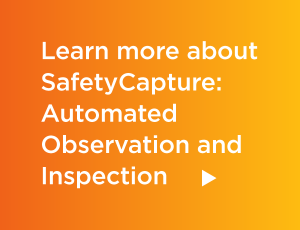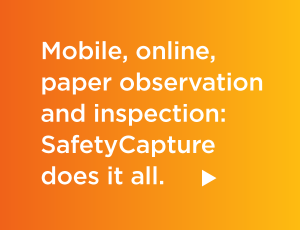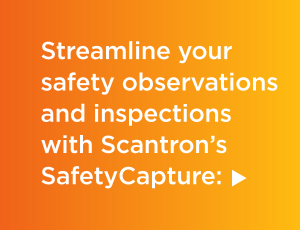 It can be a tall order to maintain functional communication about safety. In the struggle to keep often under-funded safety programs moving forward, many organizations look for ways to minimize the sheer manual effort required to collect, process and analyze safety observation forms. Increasingly, safety professionals and leaders are turning to data automation innovations that help to eliminate manual data entry bottlenecks by moving raw data out of paper forms and into online reporting and analysis tools. This is an essential operational step that accelerates data availability (generally hours instead of days or weeks), an urgent need that can make or break the success of a BBS program.
It can be a tall order to maintain functional communication about safety. In the struggle to keep often under-funded safety programs moving forward, many organizations look for ways to minimize the sheer manual effort required to collect, process and analyze safety observation forms. Increasingly, safety professionals and leaders are turning to data automation innovations that help to eliminate manual data entry bottlenecks by moving raw data out of paper forms and into online reporting and analysis tools. This is an essential operational step that accelerates data availability (generally hours instead of days or weeks), an urgent need that can make or break the success of a BBS program.
Once the data is collected and analyzed, what’s the best approach for communicating its valuable insight to the employees within the organization? Safety observations have different value for stakeholders throughout any large production facility, manufacturing plant or factory. Workers on the front lines want to see an organization’s commitment to reducing injury, but want assurance they won’t be penalized by their co-workers for singling out at-risk behaviors. The management and finance groups, on the other hand, will likely be more interested in key performance indicators that tie directly to productivity and profitability. HR might focus on the wellness components of the safety program, namely that workplace safety translates into more engaged, healthier employees and reduced employee churn.
How safety observation insights are communicated to disparate groups with different mandates and accountabilities is a critical component of the feedback process, but often organizations lack a ‘best practice’ approach that helps them capitalize on the communication opportunities.
Here are three best practices that safety professionals should take into account when designing an effective communications and feedback process:
 1. Using Technology to Accelerate the Feedback Loop
1. Using Technology to Accelerate the Feedback Loop
Regardless of the type of organizational culture and its attitude toward safety, it’s impossible to get away from the key mandates of a behavior-based safety program. If safety professionals can’t demonstrate the value of their behavioral programs through proven metrics like fewer identified hazards, reduced workplace injuries and improved production capacity, their future viability could be at stake.
Urgency and responsiveness are key. Without them, workers will become disengaged and less inclined to report observations, and management will fail to recognize the return on investment that preserves safety program budgets. That’s why even the best feedback strategy won’t succeed unless it’s enabled with the right technology support. Employing data automation is a critical part of that equation since it solves the data bottleneck issue associated with paper forms. However, the technology strategy has to also extend into the analysis and reporting systems that make data actionable for relevant groups in the organization.
Recommendations:
- In choosing data automation solutions, consider options that make it easier for you to work with your paper-based data immediately. Technology innovations that include rapid, efficient digital scanning of paper observation forms can transform a time-consuming data entry activity into a robust collection process providing near real-time data availability.
- Avoid solutions that still require arduous data validation and manual correction – these can contribute to the inefficiency of reporting and feedback programs.
- Every time you have to stop to convert and transform data across formats, you lose critical momentum in the feedback loop. Focus on integration efforts that help to remove the manual steps required to move raw form data into spreadsheets and/or online databases, or reporting systems.
- Data automation solutions that include integrated reporting capabilities help to ease the data translation and conversion burden, while providing the flexibility to produce both standard and custom reports quickly. The more efficient you can make this process, the faster you’ll get the right safety program insights into the right hands.
2. Aligning Feedback with Organizational Culture
The type of organization can play a significant role in the selection of effective feedback techniques. Union and non-union environments can often face different hurdles when it comes to communicating key safety findings. Different industry sectors also have different risk profiles that directly affect the way safety feedback needs to be communicated, and how frequently. In addition, every organization – regardless of industry type or labor structure – has a unique perspective on safety. Safety climate (how employees feel about safety at a given point in time) and safety culture (the longer-term view of an organization’s safety values and attitudes) are always evolving. As they change, feedback practices have to change, too. All of these factors create cultures with many moving parts that drive unique feedback and communication requirements.
Recommendations:
- Before implementing a feedback strategy and set of tactics, perform an audit of your workplace culture to understand its unique characteristics and needs.
- Understand the ideal balance between correcting at-risk behaviors and reinforcing positive behaviors: feedback that’s too one-sided can either threaten employee morale or not have a big enough impact on the reduction of workplace hazards.
- Choose a mix of communication methods that’s reflective of your culture: group meetings might work well in some organizations, while one-on-one coaching might work better in others. Often, the right combination of channel and approach will take some experimentation – be willing to make adjustments that will influence the positive outcomes you have defined for your safety program.
 3. The Evolution Challenge: Capturing & Communicating New Insights
3. The Evolution Challenge: Capturing & Communicating New Insights
While many emerging behavioral observation programs start small by focusing on key hazards and workplace safety issues, it’s important to drive toward evolution. When organizations become successful at using behavior-based safety to strengthen their safety cultures, future plans should always look to leveraging more value out of the program. BBS programs can lead to complacency if practitioners are content to capture the same data points all the time. While trending is critical to monitor progress over time and drive continuous improvement, it’s also vital to push the program in new directions to capture new insights.
One of the best ways to do this is expanding the scope of the communications and feedback process to move beyond key performance indicators. This might include identifying hidden threats or opportunities for improvement, but also reaching influential decision-makers proactively with trend information and insights that they might otherwise miss. The type of feedback you can communicate depends on the type of raw data you collect, and how quickly you can implement changes in your data gathering process without jeopardizing your key safety measurements.
Recommendations:
- If you’re relying on paper forms and manual data entry, gathering more data could serve to slow down your communication of key findings to the departments that rely on them. However, when you incorporate data automation and digital scanning technology, you can remove the manual entry burden from the equation. Eliminating this constraint can help you capture more information on safety observation forms without affecting existing feedback commitments (including frequency and type of reports).
- Once you improve the availability of critical safety observation data, you can stop focusing on how to move it from one system to another. You can then shift your attention to more in-depth data trending and correlation analysis that helps you capitalize on new opportunities for safety related improvements.
- Ensure that the inclusion of new reports in your feedback process doesn’t impact the delivery of the standard reports you’re already producing for core internal clients.
- Since BBS programs require support across the entire enterprise, always look for new opportunities to deliver value to other departments and stakeholders in your organization. This can help to cement organizational support, which in turn preserves the long-term viability of behavioral programs.
While getting more value from the feedback and communication process requires an ongoing commitment from safety professionals, it’s a strategy that can help behavior-based safety programs reach their full potential. Organizations that take a best practice approach will be better positioned to identify and capitalize on new opportunities for improvement, while building stronger organizational support.


Social
View our latest posts or connect with us below on Social Media.